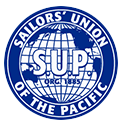Sailors' Union of the Pacific | |
 | |
| Founded | March 6, 1885 |
|---|---|
| Location | |
| Members | 736 (2005) |
Key people | Gunnar Lundeberg, president |
| Affiliations | AFL-CIO |
| Website | sailors.org |
The Sailors' Union of the Pacific (SUP), founded on March 6, 1885 in San Francisco, California, [1] is an American labor union of mariners, fishermen and boatmen working aboard US flag vessels.
Contents
At its fourth meeting in 1885, the fledgling organization adopted the name Coast Sailor's Union and elected George Thompson its first president. Andrew Furuseth, who had joined the union on June 3, 1885 was elected to its highest office in January 1887. In 1889 he returned to sea but was reelected to the position of union secretary in 1891. It was during this term [2] on July 29, 1891 that Furuseth merged the Coast Seamen's Union with the Steamship Sailor's Union with the new organization named the Sailors' Union of the Pacific.[ citation needed ]
With the exception of a two-year period when he shipped out as a fisherman, he was secretary of the SUP until 1935. [3] In 1908, Furuseth also became president of the International Seamen's Union and served in that office until 1938. [2] During this period, he successfully pushed for legislative reforms that eventually became the Seamen's Act of 1915. [2]
SUP is an affiliate union of Seafarers International Union of North America. Headquarters are in San Francisco [4] and the union has branch offices in Wilmington, California, Seattle, Washington, and Honolulu, Hawaii. SUP also has an office in Norfolk, Virginia.
